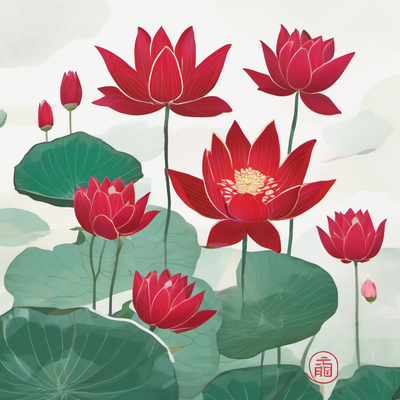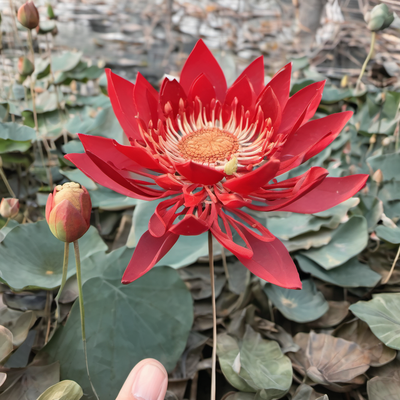
Unveil the symbolic significance and cultural interpretations of red lotus flowers in various contexts.
Red lotus flowers hold great symbolism in Buddhism. They are often associated with the concept of enlightenment and spiritual purity. Just like the lotus flower, which rises from the muddy waters to bloom in all its glory, the red lotus represents the journey towards awakening and the transformation of one's soul. In Buddhist iconography, the red lotus is often depicted as the seat of various deities and is believed to radiate positive energy and blessings. It is also seen as a symbol of compassion and love, as it is believed to be the flower that Avalokiteshvara, the bodhisattva of compassion, holds in his hand.
Another important aspect of the symbolism of red lotus flowers in Buddhism is their connection to the heart. The red color is associated with emotions and passion, and the lotus flower represents the opening of the heart chakra. It is believed that meditating on the red lotus can help one cultivate love, kindness, and empathy towards all beings.
Red lotus flowers also hold significance in Hinduism and ancient Egyptian culture. In Hinduism, the red lotus is associated with the goddess Lakshmi, who is the goddess of wealth, fortune, and prosperity. The red lotus is often depicted as the seat of Lakshmi, symbolizing her blessings and abundance. It is also believed to represent the divine feminine energy and the power of creation.
In ancient Egyptian culture, the red lotus was known as the blue lotus and was associated with the sun god, Ra. It was believed to represent rebirth, renewal, and the eternal cycle of life. The red lotus was often depicted in Egyptian art and was considered a sacred flower.
The red lotus flower holds deep psychological meaning as well. Its vibrant red color is often associated with passion, love, and desire. The sight of a red lotus can evoke feelings of excitement, joy, and sensuality. It is believed that being in the presence of red lotus flowers can uplift one's mood and ignite feelings of passion and creativity.
Moreover, the red lotus is also associated with emotional healing and transformation. It represents the ability to overcome obstacles and adversity, just like the lotus flower rising above the muddy waters. The red lotus teaches us to embrace our emotions, acknowledge our pain, and find inner strength and resilience.
Red lotus flowers have played a significant role in art and literature throughout history. They have been depicted in paintings, sculptures, and poetry, symbolizing various themes such as beauty, purity, and spirituality. In many artworks, the red lotus is portrayed as a focal point, capturing the viewer's attention and conveying a sense of awe and wonder.
In literature, red lotus flowers often serve as metaphors for personal growth, enlightenment, and the journey of the soul. They are used to convey deep emotions and explore the complexities of human existence. The beauty and symbolism of red lotus flowers continue to inspire artists and writers, serving as a powerful source of inspiration and reflection.
If you are drawn to the symbolism and beauty of red lotus flowers, there are several ways to incorporate them into your daily life. One simple way is to bring fresh red lotus flowers into your home or workspace. Their vibrant color and graceful form can instantly uplift the energy of any space and create a sense of tranquility and serenity.
You can also incorporate red lotus flowers into your meditation or mindfulness practice. Find a quiet place, close your eyes, and visualize a red lotus blooming within your heart. Imagine its petals unfolding and radiating love and compassion. Allow yourself to connect with the symbolism of the red lotus and let it inspire you to cultivate these qualities in your interactions with others.
Additionally, you can explore the world of red lotus flower symbolism through art, literature, and music. Read books or poems that feature red lotus flowers, listen to music inspired by their beauty, or even create your own artwork depicting red lotus flowers. Engaging with these creative expressions can deepen your understanding and appreciation of the red lotus and its profound meanings.

Delve into the deep symbolic meanings associated with red lotus flowers in various cultures and religions.
Red lotus flowers have a rich and fascinating history that dates back centuries. The exact origin of these beautiful flowers is uncertain, but they are believed to have originated in Southeast Asia, particularly in countries like India, Thailand, and Sri Lanka. These regions are known for their lush and vibrant landscapes, making them the perfect environment for lotus flowers to thrive.
In ancient times, red lotus flowers were often associated with creation myths and legends. They were believed to have emerged from the primordial waters, representing the birth of life and the beginning of the world. This symbolism is still prevalent in many cultures today.
In Hinduism and Buddhism, red lotus flowers hold great spiritual significance. They are often associated with deities and are considered sacred symbols of enlightenment and purity.
In Hinduism, the red lotus is closely associated with the goddess Lakshmi, the goddess of wealth, fortune, and prosperity. It is believed that the red lotus represents her divine beauty and grace. The lotus flower is also a symbol of spiritual growth and enlightenment in Hinduism.
Similarly, in Buddhism, the red lotus is highly revered and is often depicted in art and religious ceremonies. It is believed to symbolize the heart of the Buddha and is associated with love, compassion, and purity of mind. The red lotus is also believed to represent the highest level of spiritual attainment, known as enlightenment or nirvana.
In ancient Egypt, red lotus flowers held a special place in religious and cultural practices. They were often associated with the sun god Ra and were considered symbols of rebirth and regeneration.
The red lotus was believed to bloom every morning at sunrise and close at sunset, symbolizing the cyclical nature of life and the eternal renewal of the sun. It was also associated with the concept of resurrection and immortality, as the lotus flower would emerge from the muddy waters of the Nile River and bloom into a beautiful flower.
The red lotus was highly valued and often depicted in ancient Egyptian art and architecture, including temples and tombs. It was seen as a powerful symbol of divine beauty and spiritual transformation.
In Chinese culture, red lotus flowers are considered symbols of love, passion, and purity. They are often associated with summer and are believed to bring good luck and fortune.
The red lotus is also closely associated with the Buddhist concept of enlightenment and is often depicted in Chinese Buddhist art. It is believed to represent the pure and awakened heart, free from attachments and desires.
In traditional Chinese medicine, the red lotus is also valued for its healing properties. It is believed to have various medicinal benefits, such as promoting digestion, improving blood circulation, and reducing inflammation.
Overall, red lotus flowers hold a special place in Chinese culture and are deeply ingrained in the country's traditions and beliefs.
In modern times, the symbolism of red lotus flowers has expanded beyond traditional religious and cultural contexts. They have become popular motifs in art, fashion, and home decor, representing various concepts and emotions.
For some, the red lotus represents strength, resilience, and determination. It is seen as a symbol of overcoming challenges and adversity.
Others interpret the red lotus as a symbol of passion, love, and romance. It is associated with fiery emotions and intense desires.
Additionally, the red lotus can also symbolize transformation and personal growth. It represents the journey of self-discovery and the pursuit of enlightenment.
Overall, the symbolism of red lotus flowers continues to evolve and inspire people in different ways, reflecting the diverse interpretations and meanings attached to these beautiful flowers.